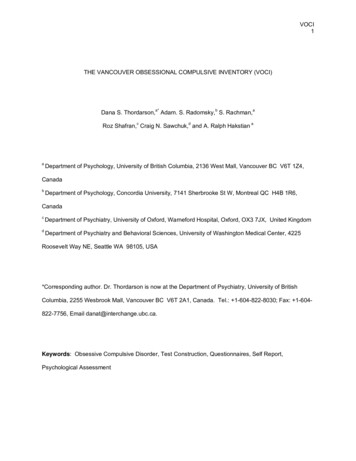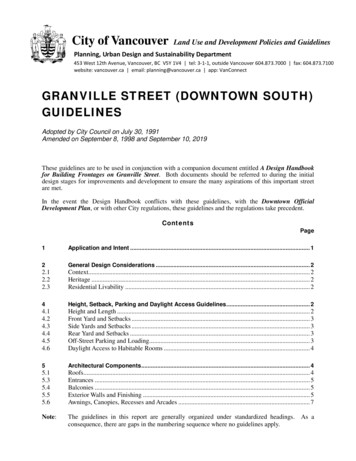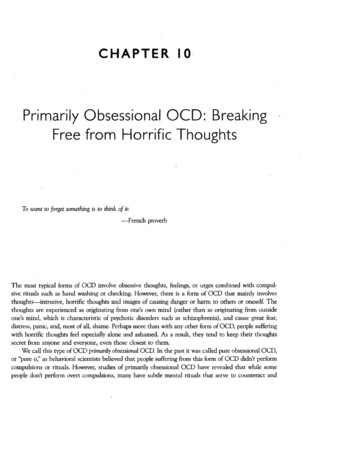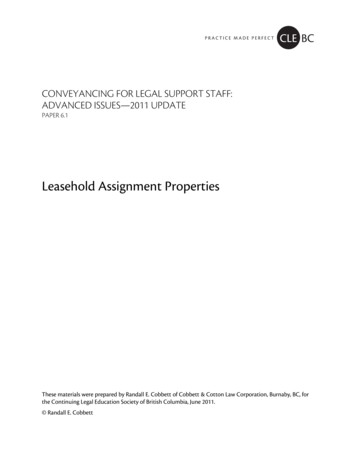
Transcription
VOCI1THE VANCOUVER OBSESSIONAL COMPULSIVE INVENTORY (VOCI)Dana S. Thordarson,a* Adam. S. Radomsky,b S. Rachman,aRoz Shafran,c Craig N. Sawchuk,d and A. Ralph Hakstian aaDepartment of Psychology, University of British Columbia, 2136 West Mall, Vancouver BC V6T 1Z4,CanadabDepartment of Psychology, Concordia University, 7141 Sherbrooke St W, Montreal QC H4B 1R6,CanadacDepartment of Psychiatry, University of Oxford, Warneford Hospital, Oxford, OX3 7JX, United KingdomdDepartment of Psychiatry and Behavioral Sciences, University of Washington Medical Center, 4225Roosevelt Way NE, Seattle WA 98105, USA*Corresponding author. Dr. Thordarson is now at the Department of Psychiatry, University of BritishColumbia, 2255 Wesbrook Mall, Vancouver BC V6T 2A1, Canada. Tel.: 1-604-822-8030; Fax: 1-604822-7756, Email danat@interchange.ubc.ca.Keywords: Obsessive Compulsive Disorder, Test Construction, Questionnaires, Self Report,Psychological Assessment
VOCI2AbstractThe original Maudsley Obsessional Compulsive Inventory (MOCI) has been widely used and isconsidered to be one of the best available self-report instruments for measuring observable obsessivecompulsive problems such as washing and checking. However, it has several limitations and requiresupdating. Our revision of the MOCI, the Vancouver Obsessional Compulsive Inventory (VOCI), wasdesigned to provide assessment of a range of obsessions, compulsions, avoidance behaviour, andpersonality characteristics of known or theoretical importance in obsessive-compulsive disorder (OCD).The development of the VOCI is described, and we provide evidence of its reliability and validity. Ourfindings in samples of people with OCD, people with other anxiety disorders or depression, communityadults, and undergraduate students suggest that the VOCI is a promising new measure. We anticipatethat, like its predecessor, the VOCI will have widespread use in both research and clinical settings.
VOCI31. IntroductionThe MOCI (Hodgson & Rachman, 1977) is a widely used self-report instrument for measuringobservable compulsive behaviour such as washing and checking. It contains 30 true/false items, withsubscales for cleaning, checking, doubting/conscientiousness, and obsessional slowness. Over the pasttwenty-five years, the MOCI has demonstrated adequate internal consistency, with good criterion,convergent, and discriminant validity (e.g., Emmelkamp, Kraaijkamp, & van den Hout, 1999; Richter, Cox,& Direnfeld, 1994). Despite its longevity as a clinical research instrument with sound psychometricproperties, the MOCI has several limitations, and requires modernizing as it was constructed in the “precognitive era.” First, the slowness subscale has been criticized as being neither internally consistent norfactorially distinct (Emmelkamp, 1988; Taylor, 1998). Second, assessment of obsessive-compulsivephenomena other than washing and checking is limited (e.g., obsessions, hoarding, covert rituals). Third,although originally designed as a research instrument, it has often been used to assess therapeuticchange; however, the MOCI is not well suited to measuring changes with treatment, both because of itsdichotomous response format, and because several items refer to past and permanent events rather thancurrent behaviour and concerns (e.g., My parents were rather strict). Finally, in order to control for theconfounding effects of response set, which was a major but exaggerated concern in 1977, half the itemsin the MOCI were negatively worded; since a number of items are worded as double negatives, patientsoften complain that they are difficult to understand, and scoring can be confusing.Other self-report measures of OCD-related thoughts and behaviour also have drawbacks. Theoriginal Padua Inventory (Sanavio, 1988) contained four subscales: checking, contamination fears,mental dyscontrol, and fear of behavioural dyscontrol. Several items were found to be measuring worryrather than obsessions, and the scale was revised by Burns, Keortge, Formea, and Sternberger (1996).Their revised scale, the Padua Inventory-Washington State University Revision, comprised fivesubscales: obsessional thoughts about harm to oneself or others, obsessional impulses to harm oneselfor others, contamination obsessions and washing compulsions, checking compulsions, and dressing andgrooming compulsions. The revised Padua Inventory has good psychometric properties and is one of themost comprehensive self-report measures of OCD, but several important groups of symptoms are notcovered, such as hoarding. The Obsessive-Compulsive Inventory (OCI; Foa, Kozak, Salkovskis, Coles,
VOCI4& Amir, 1998) is a newer inventory that assesses the frequency and distress associated with washing,checking, doubting, ordering, obsessing, hoarding, and mental neutralizing. However, both patients andclinicians have expressed some difficulty with the rating requirements of the OCI, as each item is rated ontwo dimensions (frequency and distress). Some patients report that this double-rating is somewhatconfusing and repeatedly ask for information about how to complete the scale, while others simply take avery long time to complete it. Given that patients with OCD are often extremely slow at completingquestionnaires (Rachman & Hodgson, 1980), it would be preferable to administer a questionnaire withouta double-rating requirement.Our revision of the MOCI, the Vancouver Obsessional Compulsive Inventory (VOCI) wasdesigned to provide assessment of a wider range of obsessions, compulsions, avoidance behaviour, andpersonality characteristics of known or theoretical importance in OCD, and to refine it in the light ofdevelopments over the past two decades. Each item is rated on a 5-point Likert-type scale to enhance itssensitivity to therapeutic change. All items refer to current concerns and behaviour, and are positivelycued, leading to easier administration, scoring, and interpretation. The development of the new scalebegan in 1994, and followed a construct-based approach through several stages of development,including both factor- and item-analytic strategies. Importantly, the scale is expanded beyond its originalbehaviourist basis and now includes cognitive items.2. Development of the VOCI2.1. Phase 1S. Rachman and Steven Taylor devised a pool of 172 items, organized into 13 content domainsrelevant in OCD. The item pool was administered to 183 undergraduate students. A principalcomponents analysis of each section was used to reduce the item pool by extracting the best items fromeach content domain. Results of this analysis suggested partitioning some sections into two factors whilecollapsing other domains into a single scale. An 84-item preliminary scale emerged, comprising 17internally consistent subscales. Because of the large number of subscales, the subscales werearranged logically into four clusters: Contamination, Danger, other Obsessions and Compulsions, andPersonality Characteristics. This scale was named the Maudsley Obsessional Compulsive Inventory –
VOCI5Revised (MOCI-R), with the psychometric properties presented in 1995 (Rachman, Thordarson, &Radomsky, 1995).2.2. Phase 2The 84-item MOCI-R was distributed to 272 undergraduate students, 122 community adults, 118people who reported that they had received a diagnosis of OCD, and 55 people who identifiedthemselves as having other anxiety disorders (mostly panic disorder). Our analysis of these datasuggested that the questionnaire required further revision. In particular, some subscales failed todiscriminate between people with OCD and either students or anxiety control subjects. This finding stoodin marked contrast to the good known-groups validity of the original MOCI. Furthermore, an arrangementof 17 subscales and four clusters was clearly too unwieldy for a succinct final scale. With these issues inmind, we substantially revised the 84-item version.First, we examined the factor structure of the 84 MOCI-R items, along with the 30 original MOCIitems, in the sample of OCD sufferers. Given the large number of items (114) and the relatively smallsample size (N 118), these results must be considered tentative, as the results of factor analysis can beunreliable without a high subjects-to-variables ratio. An unweighted least squares common-factoranalysis on the basis of 7 factors, with direct oblimin transformation, yielded a clear and interpretablesolution. The following factors emerged: Checking, Contamination, Indecisiveness/Perfection/Concernwith Mistakes, Obsessions, Routine/Slowness/Counting, and two thought-action fusion (TAF) factors,TAF-Moral (beliefs that bad thoughts are morally as unacceptable as bad actions), and TAF-Likelihood(beliefs that having a thought about something terrible happening increases the risk of it actuallyhappening) (see Rachman, Thordarson, Shafran, & Woody, 1995).Items loading on the two TAF factors were removed from subsequent scale revisions for anumber of reasons. We wanted to make the new questionnaire more tightly focused on OCD complaints(most of the items refer to obsessions, compulsions, and avoidance); the TAF items, being the only itemsreferring to beliefs, did not fit well with the rest of the scale, and may have contributed to difficulties withits factor structure. Furthermore, in view of the content domain of potential beliefs and appraisalsassociated with OCD, it did not make sense to retain only TAF-related beliefs. Finally, we decided to
VOCI6construct a separate scale to independently measure this belief domain (TAF Scale; Shafran,Thordarson, & Rachman, 1996). Therefore, from the 7-factor solution reported in the previous paragraph,the two TAF factors were removed.The best items from the five remaining factors (Checking, Contamination, Indecisiveness/Perfection/Mistakes, Obsessions, Routine/Slowness/Counting) were selected to form five new subscales.Items were selected on the basis of (a) their absence of factorial complexity, (b) their discriminationbetween (i) people with OCD and (ii) anxious, community adult, and student groups, and (c) their highcorrected item-total correlations, within the existing data set. A number of items were rewritten to makethem more clearly reflect pathology, in an attempt to improve their ability to discriminate among thegroups. In particular, some items were rewritten to conform more closely to the original MOCI items,especially those MOCI items that discriminated well among the groups. A new set of items thatrepresented hoarding, which was not initially included in the scale’s development, was added. Theresulting scale, now termed the Vancouver Obsessional Compulsive Inventory (VOCI), comprised 52items.2.3. Phase 3The purpose of this phase was to make a preliminary assessment of the criterion-related validityof each item and subscale, in preparation for the final validation study. The 52-item VOCI was sent toapproximately 100 members of the Participant Register of the Fear and Anxiety Laboratory at theUniversity of British Columbia (UBC), and was returned by a total of 80 participants (36 reported they hadOCD and 44 reported having another anxiety disorder or mood disorder). An additional sample of 214undergraduate students at UBC completed the questionnaires for subject pool credits. Eight studentswere excluded from analyses because of significant self-reported psychiatric history.Mean differences were examined between OCD subjects and the two comparison groups (otheranxiety disorder/depression subjects and students) on all subscales and on each item within subscales.An attempt was made to determine whether each subscale was unifactorial in both the student and OCDgroups by conducting a principal components analysis of the items within each subscale and examiningthe scree plot and the first principal component. Finally, within-groups estimates of internal consistency
VOCI7(alpha) reliability and corrected item-total correlations were examined. The results of these analyses aredescribed below. Items that were found to perform poorly were replaced with new items. In these cases,replacement items were written based on items contained in other well-established OCD measures, suchas the MOCI and Padua Inventory.Contamination. This subscale was unifactorial in both student and OCD samples. One item(Touching the floor frightens me) had a very low item-total correlation in both samples, and wasinfrequently endorsed, even by participants with OCD who reported cleaning compulsions. It wasreplaced by a different item referring to excessive use of disinfectants, based on an original MOCI item.Checking. This was unifactorial in both student and OCD samples. All items showed gooddiscrimination between participants with OCD, students, and participants with other anxiety disorders,and had high item-subscale total correlations. A few items were rewritten to improve their readability.Obsessions. This was unifactorial in students, but one item formed a single factor in participantswith OCD, and had a zero item-subscale total correlation. This item was rewritten.Hoarding. The hoarding subscale failed to discriminate between OCD and other groups ofparticipants; students in particular scored highly on most items. We revised the hoarding scalethoroughly, developing an expanded content domain based on empirical and theoretical work of Frostand colleagues (e.g., Frost & Gross, 1993).Indecisiveness/Perfection/Concern over mistakes. This was unifactorial in both student and OCDparticipants, with good discrimination among groups. Depressed non-OCD subjects tended to scorehighly, which is consistent with the fact that indecisiveness is a common feature of depression. Thus,while indecisiveness is characteristic of OCD, there is likely to be true overlap with depression, for whichindecisiveness is a diagnostic feature.Routine/Counting/Slowness. The two items on which depressed participants scored higher thanOCD participants were rewritten or replaced.Following the Phase 3 revisions, the resulting VOCI contained 55 items. The items were rerandomized in preparation for the final evaluation of the reliability and validity of the VOCI, which ispresented in the next section. Nine of the 55 items were identical or nearly identical to MOCI items(VOCI items 12, 18, 23, 25, 33, 41, 43, 47, and 53).
VOCI83. Final Validation StudyIn the final validation study, the internal consistency and test-retest reliability of the VOCI wasestimated for both the total scale and each of the six subscales, and for both normal and clinical samples.A variety of information related to construct validity was also gathered:1. The factor structure within both OCD and normal samples was examined.2. The criterion-related (known-groups) validity was evaluated in two ways. First, the scores of OCDsufferers were compared with anxiety/depression control and community adult and studentparticipants. Secondly, OCD participants were coded as to whether they had problems in each of fiveOCD symptom domains (contamination/cleaning, checking, hoarding, repugnant obsessions, andordering/repeating), based on the main OCD themes reported by the interviewer. VOCI subscalescores of OCD participants with problems in each domain were compared with the subscale scoresof OCD participants who did not have concerns in that particular domain.3. The convergent and discriminant validity of the VOCI was evaluated, by correlating it with othermeasures of OCD, measures of other problems (depression, anxiety, worry), and personality traits(neuroticism, psychoticism, extraversion). It was hypothesized that, while the VOCI would bepositively correlated with depression, anxiety and worry due to true construct overlap, strongercorrelations were expected to emerge with other measures of OCD, especially the MOCI and revisedPadua Inventory.3.1. Method3.1.1. ParticipantsOCD. The OCD sample consisted of 88 adults with a diagnosis of OCD. The diagnosis wasconfirmed by a structured diagnostic interview. The majority of participants (91%) had a primarydiagnosis of OCD; the rest had OCD symptoms significant enough to warrant clinical diagnosis, but alsohad comorbid conditions (e.g., major depressive disorder) that were rated as more severe. Participantswere recruited from several sources: Participant Register of the Fear and Anxiety Laboratory in theDepartment of Psychology, UBC (N 23); a treatment study of OCD in Traumatic Stress Clinic,
VOCI9Department of Psychiatry, UBC (N 27); a treatment study for OCD at the Anxiety Disorders Unit, UBCHospital (N 32); and Harbor View Mercy Hospital, Arkansas (N 6). The VOCI was included in thestandard questionnaire packages being offered as part of the established research protocol at each site.As a result, most participants did not complete the entire battery of measures described below. For eachanalysis, the relevant Ns are reported as they vary depending on the measures and samples involved.Demographic statistics for the samples are presented in Table 1. Forty-six OCD participants(52%) were comorbid for at least one Axis I anxiety or mood disorder: 16 were diagnosed withgeneralized anxiety disorder, 15 social phobia, 13 current major depressive disorder, 5 specific phobia, 5panic disorder, 4 posttraumatic stress disorder, 1 panic disorder with agoraphobia, and 1 bipolar Idisorder.Anxiety/Depression (A/D) Controls. The A/D control group consisted of 60 adults with DSM-IVAxis I anxiety or mood disorders other than OCD. Diagnosis was confirmed by a structured diagnosticinterview. Participants who met diagnostic criteria for OCD or were considered to have subclinical OCDwere excluded. Twenty-nine participants had a diagnosis of current major depressive disorder, 20 panicdisorder with agoraphobia, 18 panic disorder, 10 generalized anxiety disorder, 7 social phobia, 6posttraumatic stress disorder, 2 specific phobia, 3 dysthymic disorder, 1 anxiety disorder not otherwisespecified, and 1 bipolar II disorder (frequencies sum to greater than 60 due to comorbidity). Participantscame from the same sources as the OCD group: the Participant Register of the Fear and AnxietyLaboratory (N 24); the OCD treatment study in the Department of Psychiatry, UBC (N 1)1; a treatmentstudy for panic disorder (with or without agoraphobia) at the Anxiety Disorders Unit, UBC Hospital (N 7); and Harbor View Mercy Hospital, Arkansas (N 28). For the same reasons as with the OCD groupabove, most participants did not complete the entire battery of measures described below, and the Ns foreach analysis are reported.Community Adults. The pool of participants consisted of 42 adults. They included familymembers, friends, and acquaintances of the Fear and Anxiety Laboratory researchers, as well as friends,family members, and co-workers of participants who distributed additional questionnaires. Of the 42participants, 5 reported that they were currently suffering from depression, an anxiety disorder, or othermental health problem. Of these five, two reported that their problem was currently causing only slight
VOCI10interference in their lives, and these participants were retained. The other three participants reported thattheir problem caused definite interference in their lives. These three participants were also the onlyparticipants in the Community Adults sample who scored above 20 on the Beck Depression Inventory(BDI). As it appeared likely that these three participants were currently suffering from a mood or anxietydisorder, they were excluded from the sample, leaving a group of 39 community adults.Students. The pool of student participants consisted of 223 psychology undergraduates whocompleted the questionnaires for subject pool credits. For a portion of the sample, information aboutcurrent psychiatric problems (including depression and anxiety disorders) was available, but unlike in theadult sample, self-reported psychiatric problems had a poor correspondence with BDI scores. Of the 123participants for whom this information was available, only 2 reported experiencing problems that definitelyor severely interfered with their lives, but an additional 8 participants had BDI scores over 20. Because ofthis lack of correspondence, and because BDI scores were available for the entire sample, a cut-off score(BDI greater than 20) was used to eliminate participants who were likely to be suffering from emotionalproblems such as depression.2 Using this criterion, 23 participants were eliminated (10.3% of thesample), leaving a sample of 200 students.3.1.2. Diagnostic InterviewsThe purpose of the diagnostic interview was to establish DSM-IV diagnoses of anxiety and mooddisorders, and to rule out psychotic disorders. OCD and A/D control participants were interviewed, usingeither the Anxiety Disorders Interview Schedule for DSM-IV (ADIS-IV; DiNardo, Brown, & Barlow, 1994),or the Structured Clinical Interview for DSM-IV Axis I Disorders (SCID-IV; First, Spitzer, Gibbon, &Williams, 1997). Trained interviewers, all of who were investigators or research assistants in the Anxietyand Fear Laboratory, the Traumatic Stress Clinic, or the Anxiety Disorders Unit, administered thediagnostic interviews.3.1.3. Measures Used to Establish Convergent ValidityYale-Brown Obsessive-Compulsive Scale (YBOCS) (Goodman et al., 1989). The YBOCS is aninterviewer-rated scale that measures the severity of obsessions and compulsions without regard to their
VOCI11domain. The YBOCS has excellent interrater reliability with trained interviewers, and good criterionrelated and convergent validity; however, it tends to be highly correlated with depression (see Taylor,1998, for a review). Trained interviewers administered the YBOCS to most of the participants with OCD.The OCD participants from the treatment study at the Traumatic Stress Clinic were administered a newversion of the YBOCS, the DYBOCS (J. F. Leckman et al., unpublished scale), which yields globalseverity scores in a different metric than the original YBOCS. For the OCD group, the YBOCS orDYBOCS interview provided the means of determining the primary, secondary, and tertiary themes of theobsessional-compulsive problems.Self-report Yale-Brown Obsessive-Compulsive Scale (YBSR). The self-report version of theYBOCS used in this study consisted of the definitions of obsessions and compulsions from the originalYBOCS, space for respondents to write-in any obsessions or compulsions, and the 10 items from theoriginal YBOCS rewritten in a self-report format assessing the severity of the obsessions andcompulsions. Several studies have shown that self-report versions of the YBOCS have good reliabilityand correlate well with the original YBOCS interview scores (Steketee, Frost, & Bogart, 1996; Warren,Zgourides, & Monto, 1993).Maudsley Obsessional Compulsive Inventory (MOCI) (Hodgson & Rachman, 1977). The MOCIis a 30-item true/false questionnaire assessing OCD symptoms across four domains: Washing, Checking,Doubting/conscientiousness, and Slowness. The total scale as well as the washing and checkingsubscales have been shown to have good test-retest reliability, internal consistency, known-groupsvalidity, and convergent and discriminant validity (see Taylor, 1998).Padua Inventory, Washington State University Revision (PI) (Burns, Keortge, Formea, &Sternberger, 1995). This revised version of the original Padua Inventory (Sanavio, 1988) was usedbecause it was designed to specifically assess obsessions rather than worries. The PI contains 39 items,with 5 subscales: Contamination Obsessions and Washing Compulsions; Checking Compulsions;Dressing and Grooming Compulsions; Obsessional Thoughts about Harm; and Obsessional Impulses toHarm. The PI has demonstrated good internal consistency, test-retest reliability, known-groups validity,and discriminant validity (see Taylor, 1998, for a review).
VOCI123.1.4. Measures Used to Establish Discriminant ValidityBeck Depression Inventory (BDI) (Beck & Steer, 1993a). The BDI is a widely used 21-item selfreport measure of depression. Its reliability and validity have been well established (see Beck, Steer, &Garbin, 1988).Beck Anxiety Inventory (BAI) (Beck & Steer, 1993b). The BAI is a 21-item self-report measure ofclinical anxiety. Its validity and reliability have been well established (see Beck, Epstein, Brown, & Steer,1988). Recent research suggests that the BAI is particularly useful in measuring symptoms of anxiousarousal, rather than worry or tension (Antony, Purdon, Swinson, & Downie, 1997).Penn State Worry Questionnaire (PSWQ) (Meyer, Miller, Metzger & Borkovec, 1990). ThePSWQ is a 16-item questionnaire designed to measure the tendency to worry. It is valuable as adiscriminating measure, as worries and obsessions have been both conceptually and empiricallydifferentiated in the literature (e.g., Turner, Beidel, & Stanley, 1992).Eysenck Personality Questionnaire-Revised (EPQ-R) (Eysenck & Eysenck, 1983). The EPQ-Rin its short form is a 48-item questionnaire that yields measures of the personality traits Neuroticism,Psychoticism, and Extraversion.3.1.5. ProceduresOCD and A/D Control Samples. Participants completed the structured diagnostic interview andYBOCS, if applicable, in the clinic or laboratory. Subjects were then given the questionnaire package tocomplete at home and return to the clinic on their next visit, or mail to the laboratory in a stampedenvelope. A subset of participants with OCD completed the VOCI again after a test-retest intervalranging from 2 weeks to 3 months, depending on the project.Community Adults. The community adults were either given the questionnaire in person throughfamily and friends of the researchers, or had questionnaires distributed to their workplaces. Selfaddressed stamped envelopes were provided in which the questionnaire package could be returnedanonymously to the laboratory.Students. Student participants responded to notice-board advertisements of Psychology SubjectPool studies and picked up questionnaire packages at the Fear and Anxiety Laboratory. Participants
VOCI13completed the questionnaire packages at their convenience and returned them to the laboratory toreceive course credits. Upon returning them to the laboratory, participants who had completed the VOCIat least one week earlier were asked to complete the VOCI again in the laboratory. We obtainedadditional test-retest data from participants who participated in a second study through our laboratory.The test-retest interval ranged from 7 to 18 days (M 11 days).3.2. Results3.2.1. Missing Data and OutliersFor all the self-report scales, participants who had valid responses for at least 80% of the itemswere given pro-rated scale scores. This approach to missing data prevents the large loss of participantsfor multivariate procedures. Estimating total scores based on items completed by the participant providesan accurate estimate of participants’ true scores provided the scales have high internal consistency. Toprevent inflation of estimates of internal consistency, missing data were not replaced at the item level.Prior to the factor analysis conducted with the OCD sample, one potential outlier was found, andthe potential effects of this participant’s extreme response to one item were reduced by substituting a lessextreme value for the item for this participant for the factor analysis. For the test-retest reliability analysis,two outliers were detected within the sample of students who had completed retest questionnaires;because deleting these outliers had a negligible effect on the test-retest reliability estimates, these caseswere retained. For the known-groups validity analysis, several outliers were detected in the VOCIsubscales within the control samples (A/D, adults, and students), but none in the OCD sample. Becausedeleting these outliers had a trivial effect on the subscale means and the results of the analysis, theoutliers were retained to improve the generalizability of the results. In the convergent and discriminantvalidity analysis, there were no outliers detected on any of the scales within the OCD group. However,the other samples contained several outliers, and deleting the extreme values (retaining the rest of thedata from that case) was found to have, at least in some cases, a substantial effect on the size of thecorrelation coefficients. Therefore, these results were obtained for the data set with outliers deleted.
VOCI143.2.2. Factor Structure and Examination of SubscalesA factor analysis of the 55 items of the VOCI was conducted with the OCD sample (n 88). Theresults of this factor analysis must be considered provisional, as the low subjects-variable ratio reducedthe reliability of the factor loadings. It was not possible to pool the A/D control sample with the OCDsample to increase the number of observations, because the variance-covariance matrices of the twosamples were significantly different, based on Box’s test (M 4754.31, F (1540,44060) 1.66, p .001).The factor analysis was conducted using pairwise deletion of missing data in order to preserve as manyobservations as possible.A scree plot of the eigenvalues suggested 5 or 6 factors. Five-, 6-, and 7-factor solutions wereobtained using unweighted least squares (MINRES) common-factor analysis, with direct oblimintransformation (δ 0), and the factor pattern matrices were examined for simple structure andinterpretability. In the 5-factor solution, there were seven items with complex factor pattern coefficients(items with coefficients .3 on more than one factor), including three items with coefficients .3 on atleast three factors. The factors were easily interpretable, corresponding to contamination, hoarding,obsessions, checking, and a mixed factor of indecisiveness, needing things to look or feel just right, andcounting, memorizing, and repeating compulsions. The 6-factor solution had better simple structure, withonly two complex items and one item with
b Department of Psychology, Concordia University, 7141 Sherbrooke St W . 7JX, United Kingdom . d . Department of Psychiatry and Behavioral Sciences, University of Washington Medical Center, 4225 Roosevelt Way NE, Seattle WA 98105, USA . 1994). Despite its longevity as a clinical research instrument with sound psychometric .










